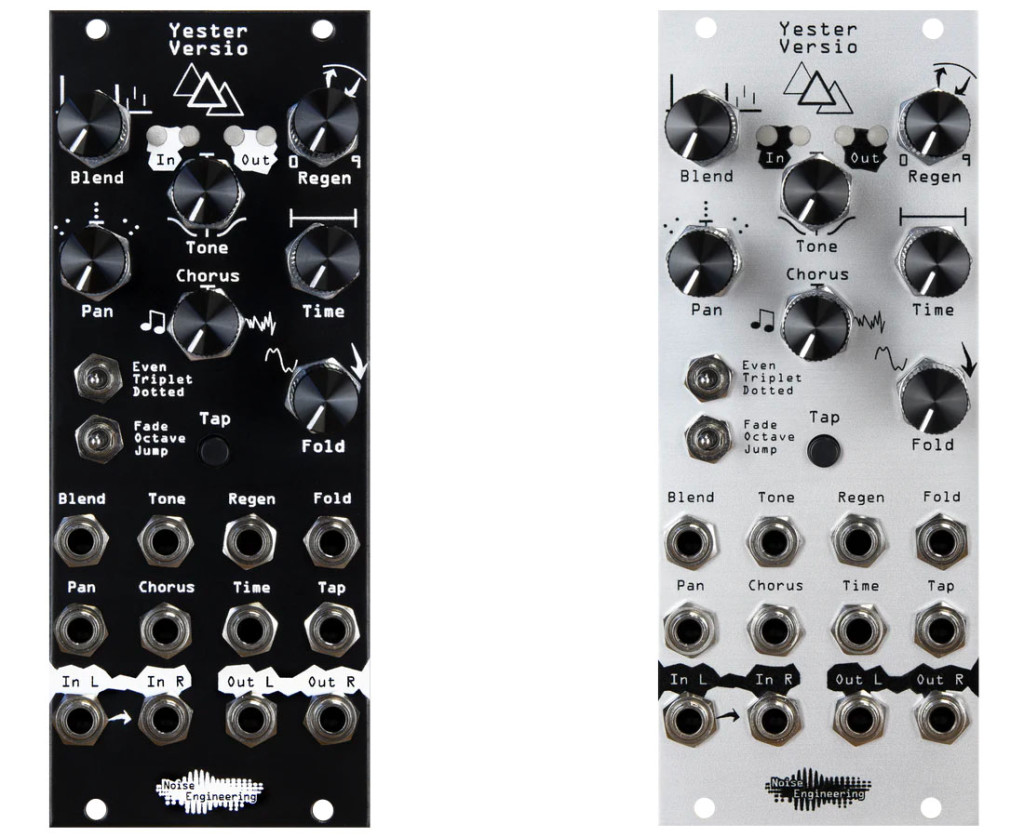Yester Versio adds a bunch of sound-shaping and performance controls to a three-tap delay it what looks like a promising package. It’s the latest addition to Versio, their stereo module line that lets you swap firmwares at will – meaning you might just get this for free when it arrives this week.
Noise Engineering has two such platform. Legio is the slimmer and more inexpensive one; Version is the wider stereo one. Cost of entry into the latter is US$393, but once you’ve done that, you can swap firmwares and even order pre-printed faceplates to match. (Then again, a laser cutter and a Sharpie might be more fun – same result, usability wise!) See below.
Yester Version starts as a stereo three-tap delay, but of course this is Noise Engineering so you can bet there are features for intensive feedback, modulation, wavefolding, and general doom. I mean, the fun kind of chaos and doom, not the sort of “what’s in the news today” chaos and doom.
Here’s what you’ve got – and yes, parameters and patch points for everything:
- Wet/dry Blend
- Panning
- Delay feedback (“Regen” in Noise Engineering parlance), ranging from 0 – 95% (so not like the really unruly Regen they use on the Desmodus plug-in!)
- Time – free or synced, with even/triplet/dotted on a three-way toggle*
- Tap button for sync (plus Tap input, which is a clock in)
- Tone – lowpass to the left, highpass to the right. (They call this “DJ-style” in the product description)
- Bipolar chorus – that’s either constant pitch shift (turning to the left) for a nice harmonic effect or LFO + pitch shift for chorusing (to the right)
- Fold – saturation – wavefolder (to the left), then “slightly chaotic suboctaves” – the signature Noise Engineering “Doom” setting (to the right)
- Fade/Octave/Jump switch – so fade/jump is obvious, determining repitching and artifacts; octave actually rate-limits changes for octave harmonies, a bit more rare

Now note that there isn’t a free/sync switch per se, but that’s easy enough – they just treat it as a continuous free input if there’s no Tap input (from the button or Tap in), and quantize it once you add clock or your own button presses. I had to check the manual on that one to be sure:
When there’s no clock input at the Tap jack and a tap tempo hasn’t been entered, this controls the rate of the internal delay clock. If a tap tempo has been entered, this acts as a clock divider/multiplier, in conjunction with the Even/Triplet/Dotted switch. Divisions are to the left of 12:00 and multiplications to the right.
That’s a nice solution. And while I’ve already said I’m a huge fan of endorphin.es Ghost, Yester Versio is probably a better option if you’re really focused on the delay portion with sound shaping – and there are no strange button presses to memorize. The two could also complement one another because of their difference in approach but overlapping combination of stereo delay and sound coloration.
What enables the custom firmwares on Noise Engineering’s platforms, by the way, is libDaisy, so you could write your own firmware for the same platform. That saves you the work of building a whole module around Daisy on your own, though if you’re really ambitious you could go totally DIY. (More on Daisy in a separate story.)
The World of Versio page covers hacking, updates, the works.
Versio already looked good, but this might be the firmware that puts it over the top in my book. The combination of stereo delay, tone controls, and Noise Engineering’s usual brutally destructive approach to folding/distortion looks irresistible. I’m already hugely happy with their Regio platform, plus for analog distortion, their Terci Ruina module.
But being able to add a Versio to your setup and swap it between some really unique reverbs, distortions, and delays seems ideal.
Affiliate links: [CDM benefits from sales generated via our affiliate partners]
Ruina Versio Stereo Distortion [Perfect Circuit]
Electus Versio Stereo Clocked Reverb [Perfect Circuit]
Desmodus Versio Stereo Reverb [Perfect Circuit]
More:
Previously:
And on Regio: